Healthcare Operational Analytics Market Size
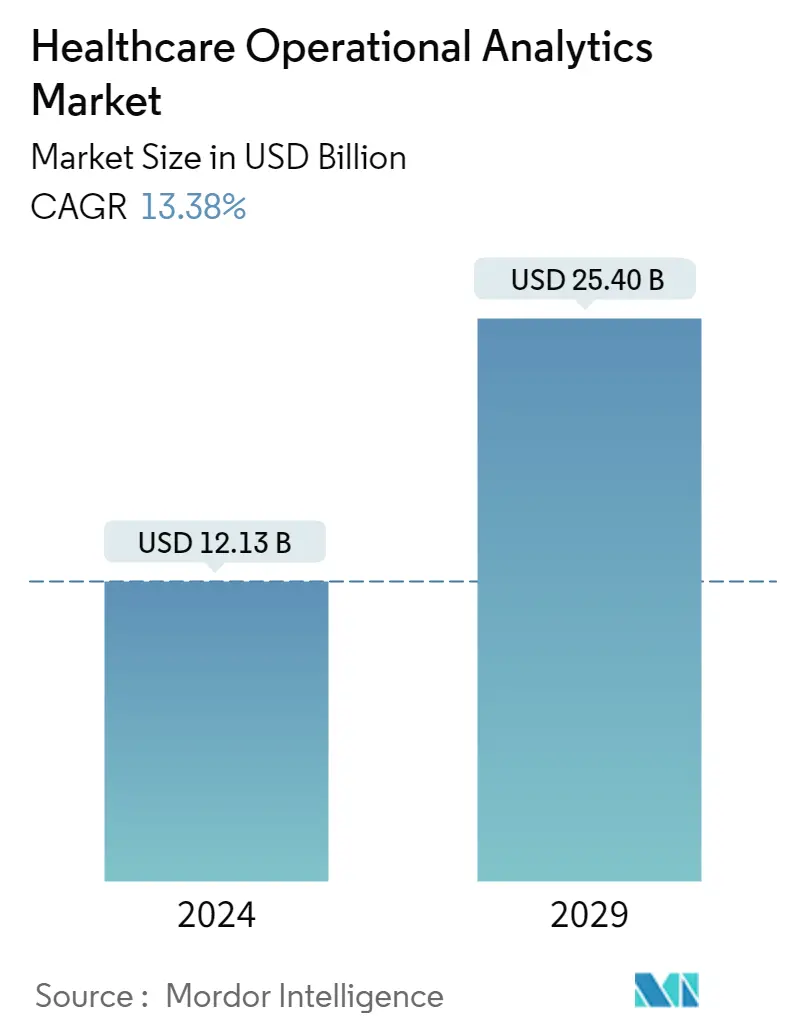
| Study Period | 2018 - 2029 |
| Market Size (2024) | USD 12.13 Billion |
| Market Size (2029) | USD 25.40 Billion |
| CAGR (2024 - 2029) | 13.38 % |
| Fastest Growing Market | Asia-Pacific |
| Largest Market | North America |
Major Players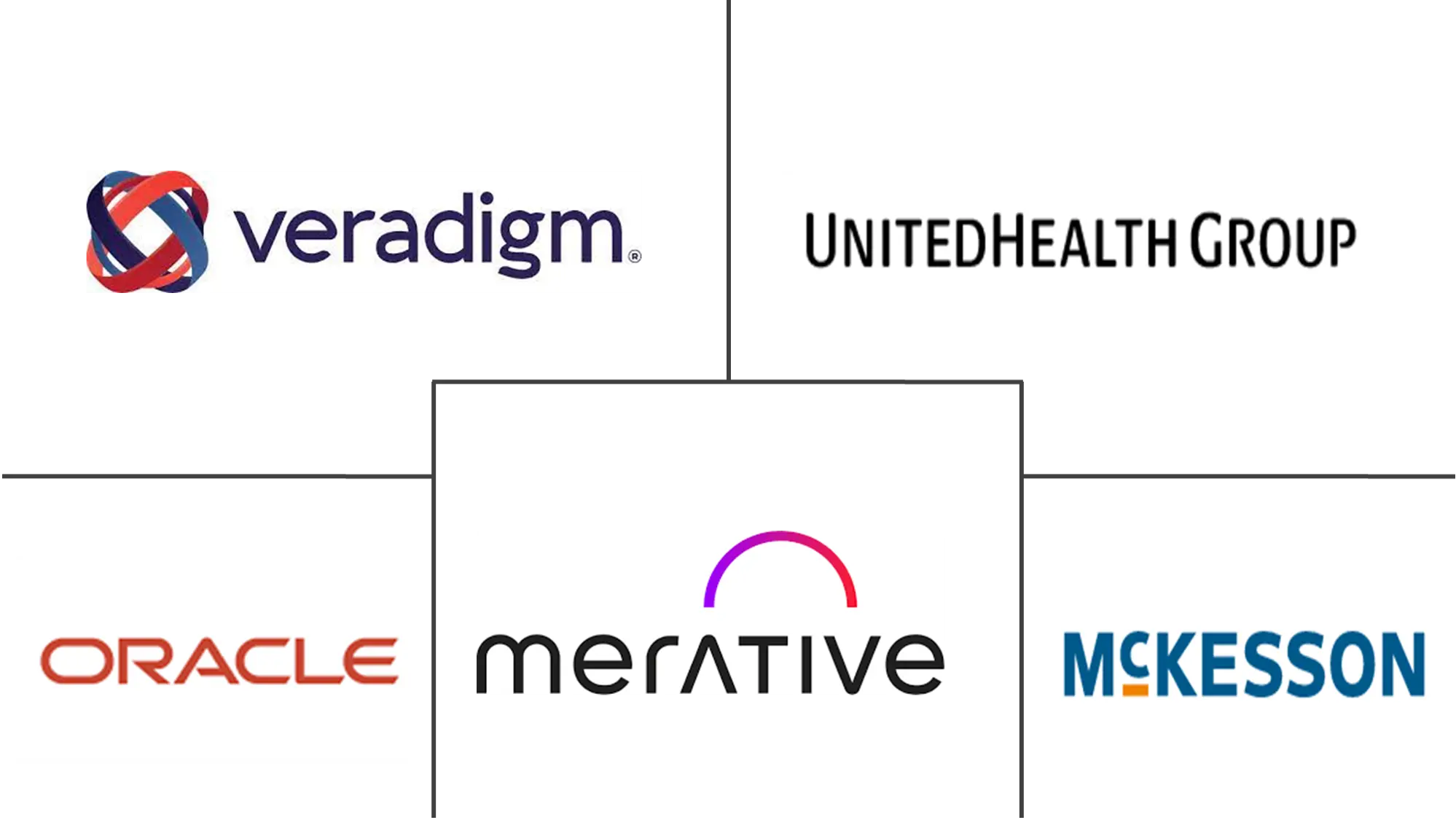
*Disclaimer: Major Players sorted in no particular order |
Healthcare Operational Analytics Market Analysis
The Healthcare Operational Analytics Market size is estimated at USD 12.13 billion in 2024, and is expected to reach USD 25.40 billion by 2029, growing at a CAGR of 13.38% during the forecast period (2024-2029).
- The COVID-19 pandemic had a significant impact on healthcare operational analytics, transforming the way healthcare organizations utilize data and analytics to manage their operations. One of the most immediate effects was the heightened demand for real-time data to track the spread of the virus, predict resource needs, and allocate resources efficiently. For instance, a book released by the Head of Cybersecurity of the UAE Government in May 2023 revealed that artificial intelligence and big data played a crucial role in tracking and predicting the spread of COVID-19, identification of vulnerable populations, and analysis of high-risk areas for efficient containment and mitigation measures. Therefore, the COVID-19 pandemic accelerated the adoption of data-driven decision-making in healthcare operations, highlighting the need for real-time data analytics, supply chain optimization, and the integration of telehealth data. These changes have not only improved crisis response capabilities but have also set the stage for a more data-driven and resilient healthcare system in the post-pandemic era.
- The major factors driving the market growth include increasing demand for value-based care (VBC), rising need to analyze the collected healthcare data, and rising awareness regarding healthcare standards and improving technologies. The demand for value-based care in healthcare is increasing for several reasons, driven by a desire to improve the overall quality and efficiency of healthcare delivery while managing costs. Some of the key factors contributing to the growing demand for value-based care include a focus on patient outcomes, cost containment, chronic disease management, advancement in health technology, and others. For instance, according to the report published by the National Health Authority of India in 2022, the government of India is shifting its focus from volume-based to value-based healthcare under its Pradhan Mantri Jan Arogya Yojana (PM-JAY) program by establishing PM-JAY Quality Certification Program which provides bronze, silver, and gold certification for the enlisted healthcare providers (EHCPs). Also, as per the same source, this 3-tier certification program has been launched to help hospitals improve their quality and patient safety, and the enlisted hospitals qualifying for the certification receive financial incentives linked to different levels of accreditation/certifications. This instills the importance and necessity of VBC, thereby increasing their adoption by more healthcare providers.
- In addition, the surging support from government bodies is also projected to drive market growth during the forecast period. For instance, in January 2023, the National Health Authority (NHA) of India launched the Digital Health Incentive Scheme (DHIS) to boost digital health transactions in India under the Ayushman Bharat Digital Mission (ABDM). Under the DHIS, the government has allocated INR 4 crore (USD 500,000) for clinics, diagnostic centers, hospitals, and laboratories based on the number of digital health records created and linked to the Ayushman Bharat Health Account. Such initiatives are expected to boost the adoption of healthcare analytics solutions as they can help streamline and enhance the healthcare system of countries.
- Moreover, with the rising demand for value-based care and healthcare data analysis, as well as the generation of huge amounts of healthcare data with digitalization, the companies in the studied market are continuously engaged in research and development activities to enhance the capabilities of their offerings and launching new products/solutions in the market which is further expected to boost the market's growth. For instance, in June 2023, Syntax Health launched a platform that removes friction in the contracting process using analytics, infrastructure, and a collaborative Virtual Workspace. As per the company, its new two-sided software-as-a-service solution allows payers and providers (as well as actuaries, network managers, and analysts) to collaborate in creating a value-based contract.
- Therefore, due to the increasing demand for value-based care, the rising need to analyze the collected healthcare data, and rising awareness regarding healthcare standards and improving technologies, the market studied is expected to witness significant growth. However, concerns regarding data privacy and security and the lack of trained IT professionals in healthcare may hinder the market's growth.
Healthcare Operational Analytics Market Trends
Software Component is Expected to Witness Significant Growth Over a Forecast Period.
- Healthcare operational analytics software helps in processing and analyzing the massive amounts of data that a healthcare organization regularly collects into actionable insights that impact the operation of healthcare facilities, which is an important factor for positive patient outcomes. These operational software help organizations increase efficiency, measure progress, and improve performance. They are also easy to implement, use, and fully integrated with financial and operational data to work and point the organization in the right direction. Other factors that are expected to drive the segment growth include the implementation of advanced technologies such as artificial intelligence (AI), the development of new healthcare operational software, and the increasing development of new healthcare facilities such as hospitals around the world.
- The rising implementation of advanced technologies such as artificial intelligence (AI) and machine learning (ML) in healthcare operational analytics software is expected to enhance segment growth, as it would lead to the rising adoption of such software. For instance, Qventus is an AI-based software platform that optimizes patient flow across the hospital, including emergency departments and inpatient units. This software provides pre-defined software components that support best practices in operational processes in healthcare organizations. Similarly, VisAnalytics is a healthcare operation analytics software by Visualutions that provides a visual method of discerning very large amounts of data without the need for time-consuming manual data processing and operational analysis. Thus, the development of such AI and ML-based healthcare operational analytics software is expected to enhance the segment growth.
- Furthermore, an article published in August 2022 by Learning Health Systems stated that as the quantity and complexity of health data grows, it is critical for healthcare organizations to devise operational analytic strategies that power data innovation, and for that, the adoption of advanced technologies such as healthcare operational analytics software is necessary. According to the same source, Seattle Children's Healthcare System (Seattle Children's) is an organization that has built an operating model software that integrates analytics into its business and daily operations. Thus, the rising need for healthcare operational analytics software and the increasing implementation in healthcare organizations is expected to boost segment growth.
- Moreover, there is capable software for the implementation of AI that can perform tasks such as thinking, learning, or decision-making required by humans. These features can be used to build prediction models to diagnose diseases in the early stages. Thus, incorporating such technologies is also driving the segment's growth. For instance, in June 2022, Eclinicalworks healthcare IT solutions promulgated that Midwest Orthopaedic Center selected eClinicalWorks for improved patient engagement plus its Cloud EHR and Revenue Cycle Management (RCM) solutions, powered by Robotic Process Automation for improved efficacy and productivity. Thus, such technological advancement in software and tools is driving the growth of this segment.
- Therefore, owing to the aforementioned factors, such as the development of AI and ML-based healthcare operational analytical software and the rising adoption of software coupled with the increasing implementation in healthcare organizations, the studied segment is expected to witness growth over the forecast period.
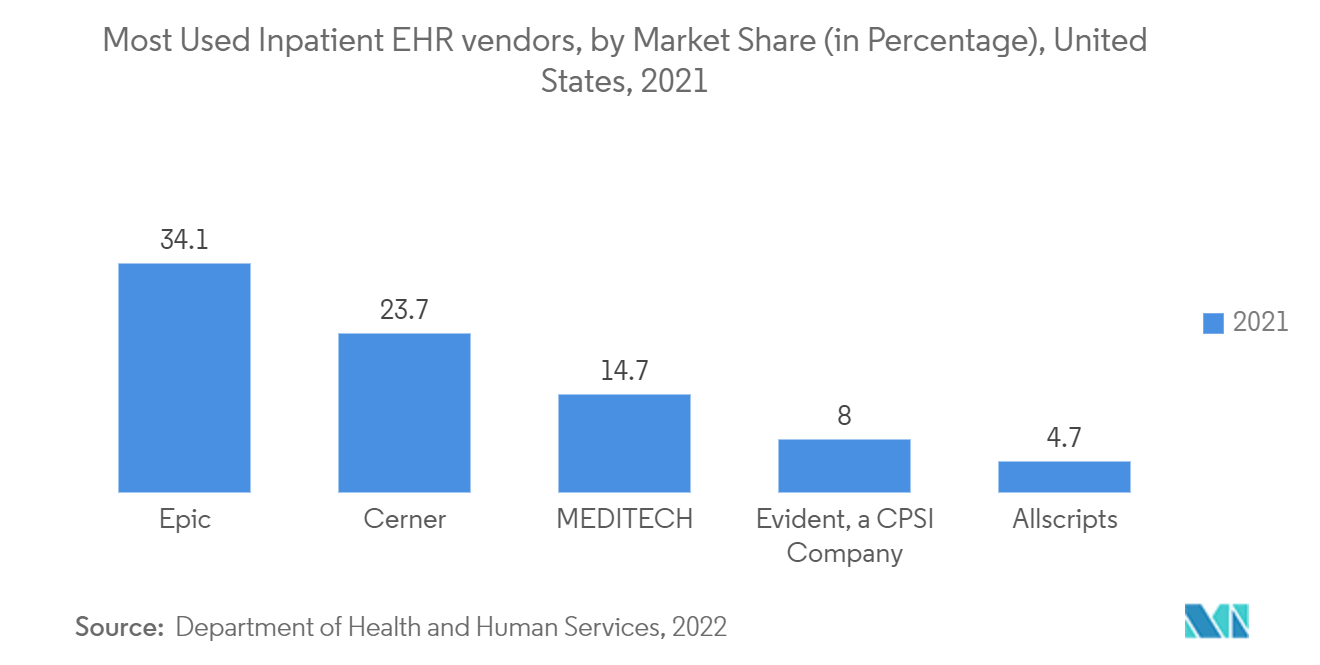
North America is Expected to Witness a Significant Growth Over the Forecast Period.
- North America is expected to experience significant growth during the forecast period of the study due to factors such as the rising usage of healthcare operational analytics in the country, advanced healthcare infrastructure, availability of technologically advanced products, the rising developments by market players such as acquisitions and product launches, and the increasing number of healthcare organizations such as hospitals in the country.
- The increasing number of healthcare organizations, such as hospitals in the country, is expected to boost the market growth in the country as it will increase the usage of healthcare operational analytics products in such organizations. For instance, as per the data published by the American Hospital Association in 2023, there are currently 6,129 hospitals in the United States in 2023, which increased from 6,093 hospitals in 2022. Such an increase in the number of hospitals in the country is expected to enhance the adoption of advanced technologies such as healthcare operational analytics for better functionality.
- Increasing the adoption of paperless technology is expected to propel the growth of the market. For instance, as per the Office of the National Coordinator for Health Information Technology report published in April 2022, 86% of non-Federal general acute care hospitals had implemented a 2015 Edition certified electronic health record (EHR). In contrast, just 40% of rehabilitation hospitals and 23% of specialty hospitals had adopted a 2015 Edition certified EHR. Thus, an increase in the adoption of electronic health records is expected to boost the healthcare operational analytics market over the forecast period.
- The developments by major market players and other organizations, such as product launches, are also expected to enhance market growth in the United States. For instance, in November 2022, Syntellis Performance Solutions launched Focus Pathway in the United States. It is a robust claims visualization platform that transforms healthcare operational claims data into actionable intelligence. Focus Pathway was originally a solution by Stratasan, which Syntellis recently acquired. Similarly, in June 2021, QAD Inc., a provider of next-generation manufacturing and supply chain solutions in the cloud, signed a partnership agreement with Virtual Integrated Analytics Solutions Mexico (VIAS). This acquisition indicates that Mexico offers lucrative growth opportunities for the market players, and the integration of QAD's portfolio with VIAS's offerings will expand their offering in Mexico, therefore positively impacting the market growth.
- Thus, owing to the launch of technologically advanced data analytics solutions coupled with the strategic initiatives by the market players, the market studied is expected to witness significant growth in the region during the forecast period.
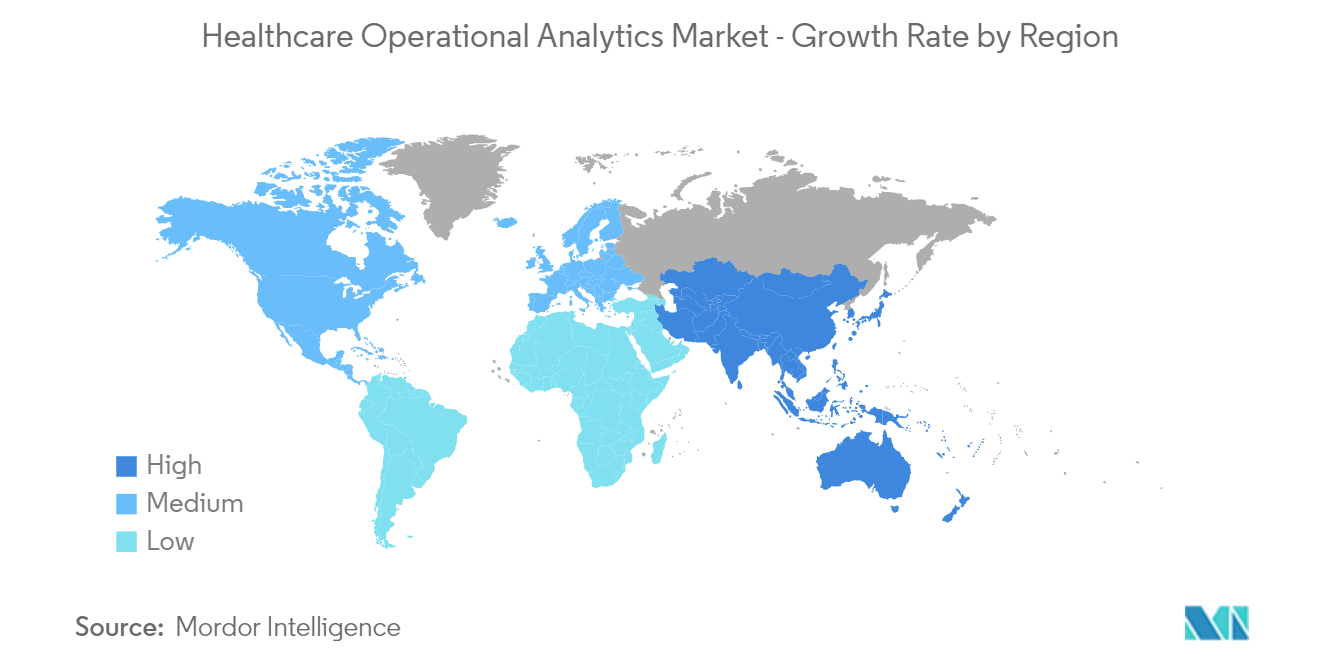
Healthcare Operational Analytics Industry Overview
The healthcare operational analytics market is moderately consolidated due to the presence of a few companies operating globally and regionally. The competitive landscape includes an analysis of a few international and local companies with significant market shares. These players are MERATIVE (IBM Watson), VeradigmLLC (Allscripts Healthcare Solutions, Inc.), Oracle Corporation (Cerner Corporation), and McKesson Corporation, among others.
Healthcare Operational Analytics Market Leaders
-
Oracle Corporation (Cerner Corporation)
-
MERATIVE (IBM Watson)
-
Veradigm LLC (Allscripts Healthcare Solutions, Inc.)
-
McKesson Corporation
-
Vizient Inc.
*Disclaimer: Major Players sorted in no particular order
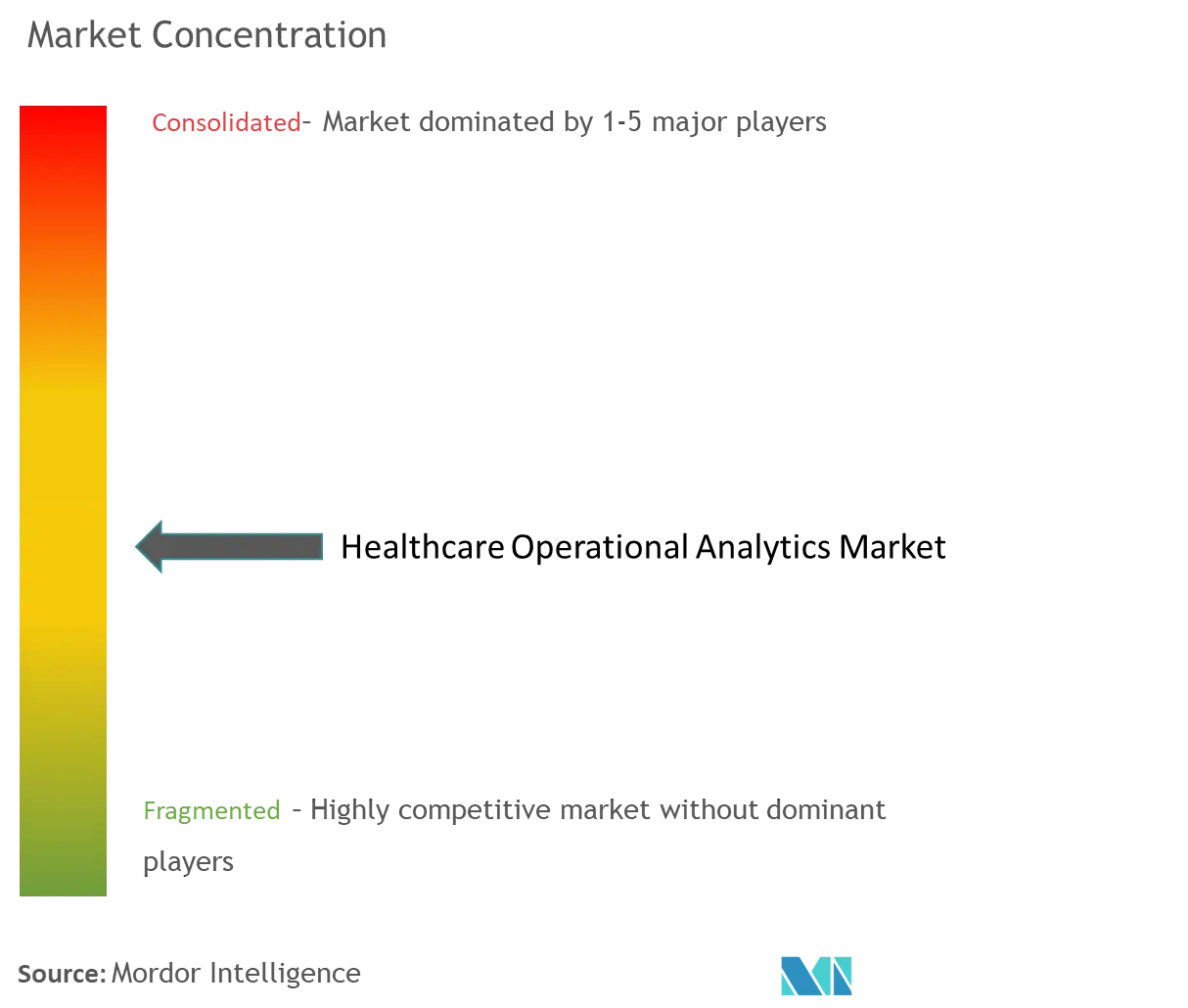
Healthcare Operational Analytics Market News
- August 2023: M3, Inc. acquired FrogwellCorporation, which is a Salesforce consulting service provider. M3 is a specialized web portal for medical professionals that delivers healthcare-related information to its 320,000+ physician members in Japan.
- June 2023: Moody's Corporation and Microsoft announced a new strategic partnership to deliver next-generation data, analytics, research, collaboration, and risk solutions for financial services and global knowledge workers. Built on a combination of Moody's robust data and analytical capabilities and the power and scale of Microsoft Azure OpenAI Service, the partnership creates innovative offerings that enhance insights into corporate intelligence and risk assessment, powered by Microsoft AI and anchored by Moody'sproprietary data, analytics, and research.
Healthcare Operational Analytics Market Report - Table of Contents
1. INTRODUCTION
- 1.1 Study Assumptions and Market Definition
- 1.2 Scope of the Study
2. RESEARCH METHODOLOGY
3. EXECUTIVE SUMMARY
4. MARKET DYNAMICS
- 4.1 Market Overview
-
4.2 Market Drivers
- 4.2.1 Increasing Demand for Value-Based Care (VBC)
- 4.2.2 Rising Need to Analyze the Collected Healthcare Data
- 4.2.3 Rising Awareness regarding Healthcare Standards and Improving Technologies
-
4.3 Market Restraints
- 4.3.1 Concerns regarding Data Privacy and Security
- 4.3.2 Lack of Trained IT Professionals in Healthcare
-
4.4 Porter's Five Forces Analysis
- 4.4.1 Threat of New Entrants
- 4.4.2 Bargaining Power of Buyers/Consumers
- 4.4.3 Bargaining Power of Suppliers
- 4.4.4 Threat of Substitute Products
- 4.4.5 Intensity of Competitive Rivalry
5. MARKET SEGMENTATION (Market Size by Value - USD)
-
5.1 By Type
- 5.1.1 Supply Chain Analytics
- 5.1.2 Human Resource Analytics
- 5.1.3 Strategic Analytics
-
5.2 By Component
- 5.2.1 Software
- 5.2.2 Hardware
- 5.2.3 Services
-
5.3 By Deployment
- 5.3.1 On-Premise
-
5.4 By En User
- 5.4.1 Hospitals and Clinics
- 5.4.2 Pharmaceutical and Biotechnology Companies
- 5.4.3 Other End Users
-
5.5 By Geography
- 5.5.1 North America
- 5.5.1.1 United States
- 5.5.1.2 Canada
- 5.5.1.3 Mexico
- 5.5.2 Europe
- 5.5.2.1 Germany
- 5.5.2.2 United Kingdom
- 5.5.2.3 France
- 5.5.2.4 Italy
- 5.5.2.5 Spain
- 5.5.2.6 Rest of Europe
- 5.5.3 Asia-Pacific
- 5.5.3.1 China
- 5.5.3.2 Japan
- 5.5.3.3 India
- 5.5.3.4 Australia
- 5.5.3.5 South Korea
- 5.5.3.6 Rest of Asia-Pacific
- 5.5.4 Middle East and Africa
- 5.5.4.1 GCC
- 5.5.4.2 South Africa
- 5.5.4.3 Rest of Middle East and Africa
- 5.5.5 South America
- 5.5.5.1 Brazil
- 5.5.5.2 Argentina
- 5.5.5.3 Rest of South America
6. COMPETITIVE LANDSCAPE
-
6.1 Company Profiles
- 6.1.1 MERATIVE (IBM Watson)
- 6.1.2 Veradigm LLC (Allscripts Healthcare Solutions, Inc.)
- 6.1.3 Oracle Corporation (Cerner Corporation)
- 6.1.4 McKesson Corporation
- 6.1.5 Vizient Inc.
- 6.1.6 MedeAnalytics, Inc.
- 6.1.7 Optum Inc.
- 6.1.8 Wipro limited
- 6.1.9 Cotiviti Inc.
- 6.1.10 Health Catalyst Inc.
- 6.1.11 CVS Health Corporation
- 6.1.12 Inovalon Inc.
- *List Not Exhaustive
7. MARKET OPPORTUNITIES AND FUTURE TRENDS
** Subject To AvailablityHealthcare Operational Analytics Industry Segmentation
As per the scope of the report, analytics helps an organization through the systematic use of technologies, methods, and data to derive insights and to enable fact-based decision-making for planning, management, operational activities, measurement, and learning. With the availability of large data sets in the healthcare industry, it has become necessary for companies to be equipped with operational analytics tools to use data efficiently.
The healthcare operational analytics market is segmented by type (supply chain analytics, human resource analytics, and strategic analytics), component (software, hardware, and services), deployment (on-premise, web and cloud-based), end user (hospitals and clinics, pharmaceutical and biotechnology companies, and other end users) and geography (North America, Europe, Asia-Pacific, Middle East, and Africa, and South America). The report also covers the estimated market sizes and trends for 17 countries across major regions globally.
The report offers the value (in USD) for the above segments.
| By Type | Supply Chain Analytics | |
| Human Resource Analytics | ||
| Strategic Analytics | ||
| By Component | Software | |
| Hardware | ||
| Services | ||
| By Deployment | On-Premise | |
| By En User | Hospitals and Clinics | |
| Pharmaceutical and Biotechnology Companies | ||
| Other End Users | ||
| By Geography | North America | United States |
| Canada | ||
| Mexico | ||
| By Geography | Europe | Germany |
| United Kingdom | ||
| France | ||
| Italy | ||
| Spain | ||
| Rest of Europe | ||
| By Geography | Asia-Pacific | China |
| Japan | ||
| India | ||
| Australia | ||
| South Korea | ||
| Rest of Asia-Pacific | ||
| By Geography | Middle East and Africa | GCC |
| South Africa | ||
| Rest of Middle East and Africa | ||
| By Geography | South America | Brazil |
| Argentina | ||
| Rest of South America |
Healthcare Operational Analytics Market Research FAQs
How big is the Healthcare Operational Analytics Market?
The Healthcare Operational Analytics Market size is expected to reach USD 12.13 billion in 2024 and grow at a CAGR of 13.38% to reach USD 25.40 billion by 2029.
What is the current Healthcare Operational Analytics Market size?
In 2024, the Healthcare Operational Analytics Market size is expected to reach USD 12.13 billion.
Who are the key players in Healthcare Operational Analytics Market?
Oracle Corporation (Cerner Corporation), MERATIVE (IBM Watson), Veradigm LLC (Allscripts Healthcare Solutions, Inc.), McKesson Corporation and Vizient Inc. are the major companies operating in the Healthcare Operational Analytics Market.
Which is the fastest growing region in Healthcare Operational Analytics Market?
Asia-Pacific is estimated to grow at the highest CAGR over the forecast period (2024-2029).
Which region has the biggest share in Healthcare Operational Analytics Market?
In 2024, the North America accounts for the largest market share in Healthcare Operational Analytics Market.
What years does this Healthcare Operational Analytics Market cover, and what was the market size in 2023?
In 2023, the Healthcare Operational Analytics Market size was estimated at USD 10.70 billion. The report covers the Healthcare Operational Analytics Market historical market size for years: 2018, 2019, 2020, 2021, 2022 and 2023. The report also forecasts the Healthcare Operational Analytics Market size for years: 2024, 2025, 2026, 2027, 2028 and 2029.
Operational Analytics in the Healthcare Industry Report
Statistics for the 2024 Healthcare Operational Analytics market share, size and revenue growth rate, created by Mordor Intelligence™ Industry Reports. Healthcare Operational Analytics analysis includes a market forecast outlook to for 2024 to 2029 and historical overview. Get a sample of this industry analysis as a free report PDF download.



